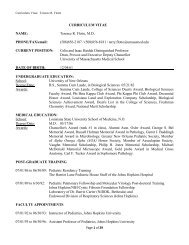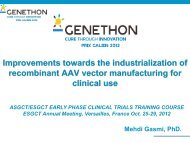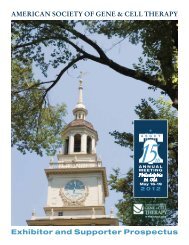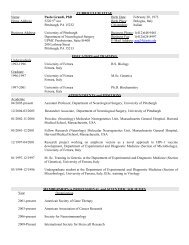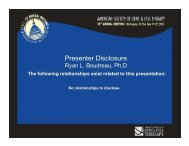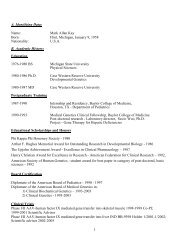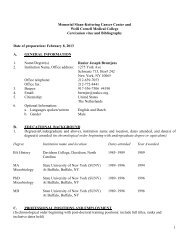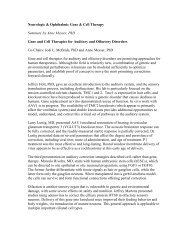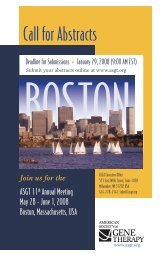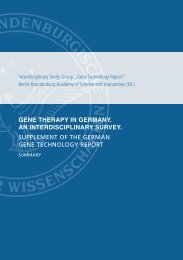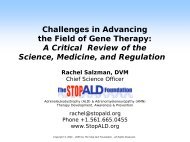13 th AnnUAL MEETing | Washington, DC USA May 19-22, 2010 27Program ScheduleWednesday, May 19Scientific Symposium 1008:30 am - 11:30 amRoom: Maryland Suite<strong>Cell</strong> <strong>Therapy</strong> BioProcessing SymposiumCo-ChairsBoro Dropulic, PhD & Thomas TillettSpeakersDavid L. Urdal, PhDManufacturing <strong>of</strong> Sipuleucel-T for the Treatment <strong>of</strong> Men with Metastatic, Castrate Resistant Prostate CancerSipuleucel-T is an autologous active cellular immunotherapy for men with late stage prostate cancer. It is comprised <strong>of</strong> a patient’s peripheral blood mononuclear cells, includingantigen presenting cells that have been cultured with a recombinant antigen delivery cassette composed <strong>of</strong> prostatic acid phosphatase and granulocyte-macrophagecolony stimulating factor. The development <strong>of</strong> sipuleucel-T will be discussed and the manufacture <strong>of</strong> this novel product candidate will be described.Gary C. du Moulin, PhD, MPHIncorporating the Concepts <strong>of</strong> Modern Quality Systems into <strong>Cell</strong>-based Product DevelopmentWell understood manufacturing processes that identify critical sources <strong>of</strong> variability can lower risk and lead to safe and efficacious treatment modalities that consistentlydeliver the intended therapeutic performance. The evolution <strong>of</strong> pharmaceutical quality systems and its focus on patient safety brings the application <strong>of</strong> a scientific approachand quality risk assessment into practice. This presentation introduces developers to the principles <strong>of</strong> risk management and quality by design, concepts that can assist ininsuring that quality attributes are identified early in the product design phase and incorporated into the control <strong>of</strong> critical processes for cell and gene therapy products.Wednesday, May 19 thJane S. Lebkowski, PhDDevelopment <strong>of</strong> Human Embryonic Stem <strong>Cell</strong>s for Therapeutic ApplicationsHESC-based regenerative cell therapies require 1) evidence for reliable production and quality control <strong>of</strong> product manufacturing, 2) rigorous safety testing in preclinicalmodels, and 3) the design <strong>of</strong> clinical trial protocols that assess the safety and benefit <strong>of</strong> the therapy in appropriate patient populations. GRNOPC1 is a population <strong>of</strong>allogeneic cells containing oligodendrocyte progenitors derived from characterized, dedicated, human embryonic stem cell banks. GRNOPC1 induces myelination <strong>of</strong> axonsin rats with spinal cord injuries and in Shiverer mice, which lack compact myelin, and also produces numerous neurotrophic factors such as midkine, BDNF, and activin.Extensive preclinical studies were performed to determine the distribution <strong>of</strong> GRNOPC1 as well as any potential toxicities after injection near the thoracic injury epicenter.Based on this IND application, the FDA has granted clearance for Geron to initiate a human clinical trial to assess the safety <strong>of</strong> GRNOPC1 in patients with subacute,complete ASIA A, thoracic injuries whose last fully preserved neurological level is T3 to T10.Madhusudan V. Peshwa, PhDUse <strong>of</strong> Flow Electroporation to Load Human <strong>Cell</strong>s to Deliver Clinically Relevant <strong>Gene</strong>s for <strong>Cell</strong> TherapeuticsThe ability to specifically enhance/augment biological function <strong>of</strong> cells using safe, non-gene modifying technologies with ability to deliver the product at clinical/commercialscale using automated, regulatory-compliant, cost-effective processes overcomes the key hurdle in developing “effective” cellular therapies. This presentation providesan overview <strong>of</strong> our experiences in development and characterization <strong>of</strong> cellular products using immune cells and stem cells that have been engineered to deliver clinicallyrelevant potency/biological activity. Specific case studies discussed will include clinical/commercial delivery <strong>of</strong> a (1) a patient-specific cellular vaccine marketed as anOncology therapy in Japan and (2) an engineered endothelial stem cell product for treatment <strong>of</strong> pulmonary arterial hypertension (PAH) in phase I/II trials in Canada.Mitchell Finer, PhDChallenges in the Manufacturing Scale-Up <strong>of</strong> hES <strong>Cell</strong> Derived TherapeuticsHuman Embryonic Stem (hES) <strong>Cell</strong>s have been traditionally derived and passaged as adherent clumps <strong>of</strong> cells on mouse or human fibroblast feeder layers. In order toproduce the quantities <strong>of</strong> cells sufficient for preclinical development and human clinical trials at an acceptable quality standard, methodology must be developed to enablexeno product free/serum free culture <strong>of</strong> hES cells as single cells in the absence <strong>of</strong> feeder lines. Further, while growth on plastic can support limited preclinical and clinicaldevelopment in some indications, achieving the scale <strong>of</strong> hES cell amplification necessary to treat diseases such as Type 1 Diabetes that require significant cell numbers(~100 billion differentiated cells), the ability to expand ES cells in suspension in the absence <strong>of</strong> differentiation, and the ability to synchronously differentiate large numbers<strong>of</strong> cells is required for product development in Type I Diabetes. Data describing the generation <strong>of</strong> feeder-free cGMP derived hES cell banks, expansion <strong>of</strong> large scalehES cell cultures in the undifferentiated state and scaled differentiation in suspension <strong>of</strong> hES-cells into pancreatic b-cell progenitors will be presented.
28<strong>American</strong> <strong>Society</strong> <strong>of</strong> <strong>Gene</strong> & <strong>Cell</strong> <strong>Therapy</strong>Program ScheduleWednesday, May 19 thMichelle Williams, PhDDevelopment <strong>of</strong> Prochymal, an Adult MSC <strong>Therapy</strong>Osiris has been developing stem cell therapies to treat unaddressed medical needs since 1992. An important part <strong>of</strong> this process has been navigating the regulatorypathway, particularly through work in the lead indication, graft-versus-host-disease. In 2005, Osiris secured the first ever Fast Track and Orphan Drug designations fromFDA for a stem cell product, followed by Orphan drug designation in Europe as well. In 2008, FDA and Health Canada granted approval for a pediatric expanded accessprogram, providing all children with severe GvHD access to our stem cell drug, Prochymal. The late stage clinical development process is an instructive case study <strong>of</strong>development <strong>of</strong> a novel therapy for a orphan indication.Scientific Symposium 1018:30 am - 11:30 amRoom: Marriott Ballroom Salon 1A Global <strong>Gene</strong> <strong>Therapy</strong> RenaissanceChairJohn Rasko, MBBS, PhDSpeakersDe-Chao Michael Yu, PhDClinical Development <strong>of</strong> KH901, a Conditionally Replicating Oncolytic Adenovirus Encoding Human GM-CSF, in Patients with Recurrent Head andNeck CancersKH901 is a conditionally replicating oncolytic adenovirus, in which the viral E1 genes are under the control <strong>of</strong> a modified telomerase promoter and a cDNA gene <strong>of</strong> granulocytemacrophage colony-stimulating factor (GM-CSF) is inserted in the E3 region. Preclinical studies have demonstrated that KH901 selectively replicates in telomeraseupregulatedand E2F-positive tumor cells and has strong anti-tumor activity. A total <strong>of</strong> 110 patients with recurrent head and neck cancer have been enrolled into clinicaltrials in which KH901 was given intratumorally while chemotherapy was the standard <strong>of</strong> care. KH901 was found to be well tolerated and safe while a significant immuneresponses and pro-longed progression-free survival were observed when compared to the chemotherapy group.Christoph Klein, MD<strong>Gene</strong> <strong>Therapy</strong> for Wiskott-Aldrich SyndromeWiskott-Aldrich syndrome (WAS) is a primary immunodeficiency disorder associated with thrombocytopenia, eczema and autoimmunity. We treated ten WAS patients bytransfusion <strong>of</strong> autologous, genetically modified hematopoietic stem cells (HSC) between 2006 and 2009. We demonstrate sustained WAS protein (WASP) expressionin HSC, lymphoid and myeloid cells, and platelets after gene therapy. T and B lymphocytes, natural killer (NK) cells, and monocytes were functionally corrected. Thepatients´ clinical condition markedly improved with respect to hemorrhagic diathesis, eczema, autoimmunity, and predisposition to severe infections. Genome-wide insertionsite analysis demonstrated vector integration that targeted multiple genes controlling growth development and immunological responses in a persistently polyclonalhematopoiesis.Yasutomo Nasu, MD, PhDProstate Cancer <strong>Gene</strong> <strong>Therapy</strong> in Japan - from HSV-tk to REIC/Dkk-3Intraprostatic therapeutic gene transduction (in situ gene therapy) is one <strong>of</strong> the potent therapeutic option for prostate cancer gene therapy aiming at antimetastatic benefitsthrough the generation <strong>of</strong> immune cell-mediated cytotoxic activities that affect not only the primary tumor but also metastatic lesion. Many clinical trials with HerpesSimplex Virus Thymidine Kinase (HSV-tk) gene therapy have been conducted in many institutes showing clinical safety and efficacy including Japanese trial (Molecular<strong>Therapy</strong> 15:834, 2007). Also immunomodulatory in situ gene therapy using adenoviral Interleukin-12 gene is under way in Japan. As a preclinical study, new therapeuticgene REIC/Dkk3 has been proved to be potential therapeutic gene for prostate cancer as it has induces local apoptosis and systemic immune activation. (Cancer Research65:9617, 2005, Cancer <strong>Gene</strong> <strong>Therapy</strong> 14:765,2007, Int J Oncol 34:657,2009, J Bio Chem 2009 online). In this symposium ongoing development <strong>of</strong> in situ genetherapy for prostate cancer will be reported with regard to systemic immune activation.EXHIBITOR PROSPECTUSfinal program
- Page 1 and 2: FINAL PROGRAMAmerican Society of Ge
- Page 4: 13 th AnnUAL MEETing | Washington,
- Page 7 and 8: 6American Society of Gene & Cell Th
- Page 12 and 13: 13 th AnnUAL MEETing | Washington,
- Page 20 and 21: 13 th AnnUAL MEETing | Washington,
- Page 22 and 23: 13 th AnnUAL MEETing | Washington,
- Page 24 and 25: 13 th AnnUAL MEETing | Washington,
- Page 26 and 27: 13 th AnnUAL MEETing | Washington,
- Page 30 and 31: 13 th AnnUAL MEETing | Washington,
- Page 32 and 33: 13 th AnnUAL MEETing | Washington,
- Page 34 and 35: 13 th AnnUAL MEETing | Washington,
- Page 36 and 37: 13 th AnnUAL MEETing | Washington,
- Page 38 and 39: 13 th AnnUAL MEETing | Washington,
- Page 40 and 41: 13 th AnnUAL MEETing | Washington,
- Page 42 and 43: 13 th AnnUAL MEETing | Washington,
- Page 44 and 45: 13 th AnnUAL MEETing | Washington,
- Page 46 and 47: 13 th AnnUAL MEETing | Washington,
- Page 48 and 49: 13 th AnnUAL MEETing | Washington,
- Page 50 and 51: 13 th AnnUAL MEETing | Washington,
- Page 52 and 53: 13 th AnnUAL MEETing | Washington,
- Page 54 and 55: 13 th AnnUAL MEETing | Washington,
- Page 56 and 57: 13 th AnnUAL MEETing | Washington,
- Page 58 and 59: 13 th AnnUAL MEETing | Washington,
- Page 60 and 61: 13 th AnnUAL MEETing | Washington,
- Page 62 and 63: 13 th AnnUAL MEETing | Washington,
- Page 64 and 65: 13 th AnnUAL MEETing | Washington,
- Page 66 and 67: 13 th AnnUAL MEETing | Washington,
- Page 68 and 69: 13 th AnnUAL MEETing | Washington,
- Page 70 and 71: 13 th AnnUAL MEETing | Washington,
- Page 72 and 73: 13 th AnnUAL MEETing | Washington,
- Page 74 and 75: 13 th AnnUAL MEETing | Washington,
- Page 76 and 77: 13 th AnnUAL MEETing | Washington,
- Page 78 and 79:
13 th AnnUAL MEETing | Washington,
- Page 80 and 81:
13 th AnnUAL MEETing | Washington,
- Page 82 and 83:
13 th AnnUAL MEETing | Washington,
- Page 84 and 85:
13 th AnnUAL MEETing | Washington,
- Page 86 and 87:
13 th AnnUAL MEETing | Washington,
- Page 88 and 89:
13 th AnnUAL MEETing | Washington,
- Page 90 and 91:
13 th AnnUAL MEETing | Washington,
- Page 92 and 93:
13 th AnnUAL MEETing | Washington,
- Page 94 and 95:
13 th AnnUAL MEETing | Washington,
- Page 96 and 97:
13 th AnnUAL MEETing | Washington,
- Page 98 and 99:
13 th AnnUAL MEETing | Washington,
- Page 100 and 101:
13 th AnnUAL MEETing | Washington,
- Page 102 and 103:
13 th AnnUAL MEETing | Washington,
- Page 104 and 105:
13 th AnnUAL MEETing | Washington,
- Page 106 and 107:
13 th AnnUAL MEETing | Washington,
- Page 108 and 109:
13 th AnnUAL MEETing | Washington,
- Page 110 and 111:
13 th AnnUAL MEETing | Washington,
- Page 112 and 113:
13 th AnnUAL MEETing | Washington,
- Page 114 and 115:
13 th AnnUAL MEETing | Washington,
- Page 116 and 117:
13 th AnnUAL MEETing | Washington,
- Page 118 and 119:
13 th AnnUAL MEETing | Washington,
- Page 120 and 121:
13 th AnnUAL MEETing | Washington,
- Page 122 and 123:
13 th AnnUAL MEETing | Washington,
- Page 124 and 125:
13 th AnnUAL MEETing | Washington,
- Page 127 and 128:
126American Society of Gene & Cell
- Page 129 and 130:
128American Society of Gene & Cell
- Page 131 and 132:
130American Society of Gene & Cell
- Page 133 and 134:
132American Society of Gene & Cell
- Page 135 and 136:
134American Society of Gene & Cell
- Page 137 and 138:
136American Society of Gene & Cell
- Page 139 and 140:
138American Society of Gene & Cell
- Page 141 and 142:
140American Society of Gene & Cell
- Page 143 and 144:
142American Society of Gene & Cell
- Page 145 and 146:
144American Society of Gene & Cell
- Page 147 and 148:
146American Society of Gene & Cell
- Page 149 and 150:
148American Society of Gene & Cell
- Page 151 and 152:
150American Society of Gene & Cell
- Page 153 and 154:
152American Society of Gene & Cell
- Page 155 and 156:
154American Society of Gene & Cell
- Page 157 and 158:
156American Society of Gene & Cell
- Page 159 and 160:
158American Society of Gene & Cell
- Page 161 and 162:
160American Society of Gene & Cell
- Page 163 and 164:
162American Society of Gene & Cell
- Page 165 and 166:
164American Society of Gene & Cell
- Page 167 and 168:
166American Society of Gene & Cell
- Page 169 and 170:
168American Society of Gene & Cell
- Page 171 and 172:
170American Society of Gene & Cell
- Page 173 and 174:
172American Society of Gene & Cell
- Page 175 and 176:
174American Society of Gene & Cell
- Page 177 and 178:
176American Society of Gene & Cell
- Page 179 and 180:
178American Society of Gene & Cell
- Page 181 and 182:
180American Society of Gene & Cell
- Page 183 and 184:
182American Society of Gene & Cell
- Page 185 and 186:
184American Society of Gene & Cell
- Page 187 and 188:
186American Society of Gene & Cell



